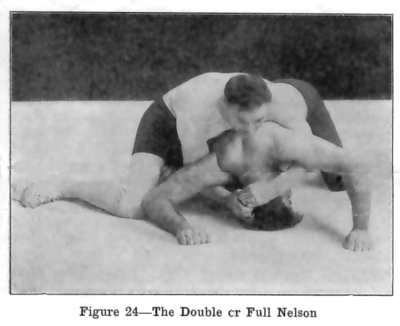The Half Nelson hold is used by professional MMA fighters and grapplers every day. However you probably first discovered it on the playground. Being put in any Nelson hold is uncomfortable and demoralizing; wrestlers use this position every day to give Jiu Jitsu practitioners problems!
This article will discuss the history of this powerful position, and also teach you a few attacks and escapes from there to add to your game.
History of the Half Nelson Hold
Like many grappling moves, the name Nelson comes from a person who used and popularized it. However, there is a bit of a debate over which Nelson the pin is named after. Many sources will tell you it was Admiral Horatio Nelson, who was a sea captain during the Napoleonic wars.
However, there was a wrestler named Bobby Nelson who brought the move to professional matches and became popular for using it. Today the move is one of the first holds that is learned when people begin wrestling, and still used at a professional level in almost all combat sports.
Difference from the Full Nelson Hold
Many positions have multiple variations and look different depending if you are on the ground or standing. Sometimes referred to as the “Nelson family,” the Nelson hold is no exception to this. Other variations of the Nelson hold include the “Quarter Nelson” and even the “3-quarter Nelson.”
The difference between the Full Nelson and the Half Nelson is that for the Half Nelson hold you’re only using one hand to pin someone’s head, while your other hand controls their wrist. The Full Nelson positions both of your hands against your opponent’s head.
Additionally, the Full Nelson is mostly seen from a standing position, while the Half Nelson is more commonly used from the turtle position in BJJ.

Attacks from the Half Nelson Hold
Although the Half Nelson is one of the simplest grappling moves, it is also one of the most effective. It can be used to pin an opponent, transition to a dominant position, or just make them uncomfortable. However, what this technique is used for the most is breaking an opponent’s posture. By putting pressure on the crown of the head, many opponents will roll or flatten out.
For BJJ players, this move is also a great opportunity to set up chokes and back takes. Firstly, the Half Nelson allows you to get someone in turtle position off their base and roll them onto their side. Secondly, the Half Nelson from the turtle position is a great position to start setting up D’arce chokes.
You might be surprised to learn that there’s even a lapel choke from the Half Nelson. Sometimes referred to as the “wing choke” it could also be called a Half Nelson choke. This choke involves gripping your opponent’s lapel the same way you would a bow and arrow choke, and using your Half Nelson grip to help apply pressure from the back of the head.
It should be noted that many BJJ practitioners, without prior wrestling experience, aren’t as familiar with this hold.
Oftentimes new white belts will attempt to take the back on opponents who are turtling, but they only succeed in off balancing themselves and needing to reset. Sometimes they even end up setting themselves up for a sweep. The Half Nelson hold is a great option in lieu of this frustrating problem.
Defenses to the Half Nelson Hold
The most common defense to this position is to clamp your arm down and look away. When your opponent shoots his arm underneath your arm, clamp your elbow around it. This will prevent him from getting his arm deep enough to reach your head.
If you are in the turtle position, bring your head up, and away from your opponent, thus making it even more difficult to reach your head.
Your opponent’s goal is to use neck pressure to immobilize you and break your posture down. It is important you don’t let your opponent get a deep enough Nelson hook to start putting too much pressure on your neck. It is also important you don’t let them grab your other arm, as this can make it difficult to move.
Finally we should note some bad defenses for the Half Nelson hold. First, don’t try to roll directly away from your opponent. Although this may seem like a good idea in the heat of the moment, it will be easier for your opponent to mount you. Another common mistake is to try and peel the hand off the head. This will raise your elbow and make it easier to roll you.
If you are looking for a defense for the Full Nelson Hold, a great tip is to lock your hands together and press on your forehead, driving against the pressure behind you. Although it might look silly and doesn’t really offer an escape, it will prevent your opponent from pressing your chin to your chest. It also opens the possibility to bring your opponent down to the ground.
Legality of the Half Nelson Hold
Fortunately, the Half Nelson hold is completely legal and is a great way to employ the power of the Nelson Hold without endangering your opponent’s neck. The Half Nelson is also a great weapon to employ when rolling with someone who has a good turtle position. This can get them off base, force them to roll, or become a setup for a choke.
It is common knowledge that the Full Nelson hold is illegal in amateur wrestling. The reason for this is it can be a brutal neck crank, causing damage to the spine. This move is especially dangerous if the person applying it has a size advantage. However, in some pro-wrestling competitions the technique is permitted.
A Full Nelson hold or a Can Opener is also illegal in IBJJF. The Can Opener can be thought of as a Full Nelson from the front and is most commonly seen when someone in closed guard pulls an opponent’s head to their chest in a Nelson Hold-like fashion. Both of these are classified as spinal locks without choke and are therefore illegal.
Conclusion
The Half Nelson hold is a great move from wrestling that many BJJ practitioners don’t utilize as much as they could. The wing choke is an incredibly powerful choke, but most players opt for the bow and arrow. Also this is a great hold for smaller players who have a difficult time unseating larger players from the turtle position.

Jack is a D who holds a bachelors degree in English Literature. He enjoys traveling, reading, and the Bow and Arrow choke. One day he hopes to teach English overseas and become a published author.
